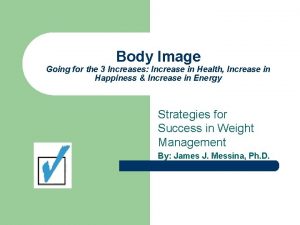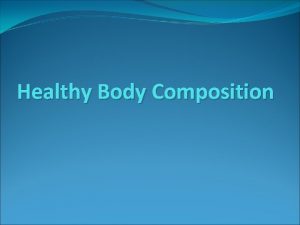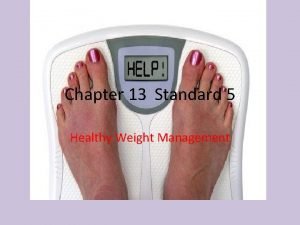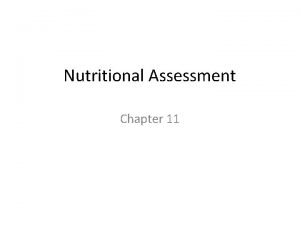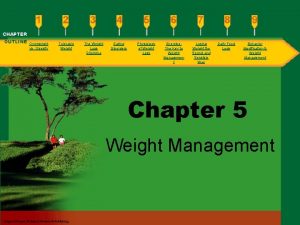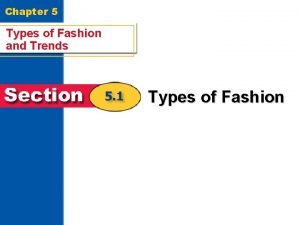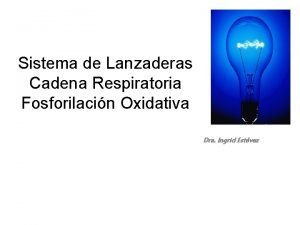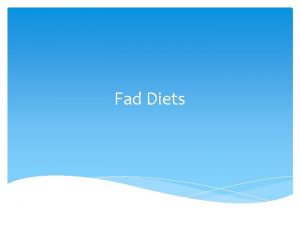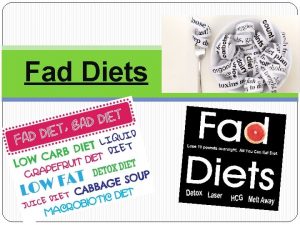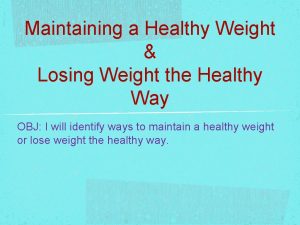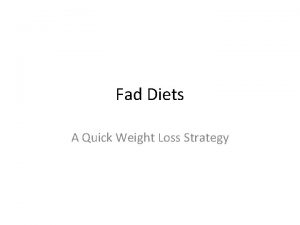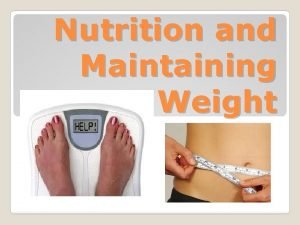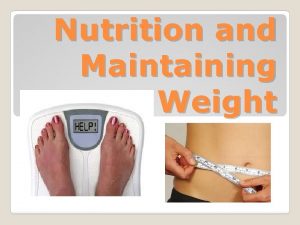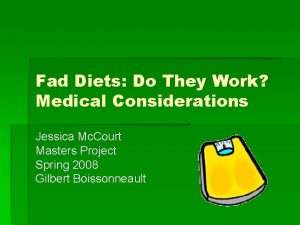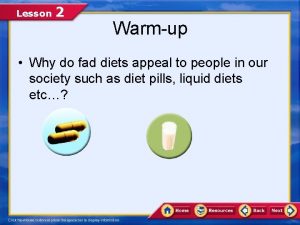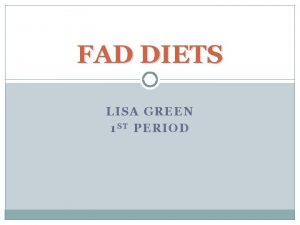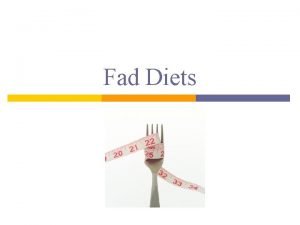Chapter 6 Maintaining a healthy weight Fad Diets































- Slides: 31

Chapter 6 Maintaining a healthy weight Fad Diets and Eating Disorders Pgs. 144 -156

T s m r e • Body image-the way you see your body. • Body Mass Index (BMI)-is a ratio that allows you to assess your body size in relation to your height and weight. • Overweight- a condition in which a person is heavier than the standard weight range for his or height. • Underweight-a condition in which a person is less than the standard weight according to his or height. • Obesity-Having an excess amount of body fat. – A sedentary lifestyle contributes to Obesity

s n a l p s s o l t h g i e w s t e i d a y l Fad n o r o f r a l u p o p e r a t tha. e m i t t r sho • Most weight lost on fad diet is regained • Fail to provide body with nutrients it needs for health and growth • Limit foods and food variety • Claim to help lose weight too quickly (more than 2 lbs. a week) • Promise to help you lose weight without giving up “fatty” foods or exercise • If it sounds to good to be true-it probably is. • Yo-yo syndrome or weight cycling is NOT an effective way to manage weight.

Examples of fad diets: • • • Atkins Grapefruit Diet Liquid Diet Cabbage Soup Diet Zone Diet South Beach Diet Paleo diet Vegan Diet 30 day challenges http: //www. medicalnewstoday. com/articles/5847. php

Liquid Diets • Can cause serious health problems and even death • U. S. Food and Drug Administration (FDA) requires these products to carry warning labels • Only to be used with close medical supervision

Diet Pills • Suppress appetite • May cause drowsiness, anxiety, racing heart • May be addictive • Some cause body to lose water; dehydration

l u f m r a h , e m e r t x e s n u a o i r e s r s e e d r s o u s a i c d n a c t a Eating h t r o i v a h e b g n i t ea. h t a e d May be brought on by: n e v e r o s s e n l il • Poor body image History of being teased about weight Family history of physical or sexual abuse Social or family pressures Perfectionism 90% female Serious health problem; and those who suffer need professional help. • It is believed that a child’s body image is determined by age 6. • Mental illness • • •

Education is truly the key to prevention. Awareness helps those at risk AVOID mistaken or judgmental attitudes about food, weight, and body shape.

Effective prevention also includes: • Developing self-esteem in other areas besides physical appearance. Examples? • Becoming a critical viewer of the media and its messages about self-esteem and body image. • Discouraging the idea that a particular weight or body size will lead to happiness and fulfillment.



Anorexia Nervosa - irrational fear of becoming obese results in severe weight loss from selfstarvation and excessive weight loss. -One out of 100 adolescent girls develop anorexia. -has consequences similar to

Anorexia Nervosa • Psychological disorder with emotional and physical consequences • Genetics may play a role • Obsession with exercising and calories • Unnatural interest in food • Distorted body image (think they are fat; no matter their size) • Denial of eating problem • Feel only control in their life is their weight.

Self-portrait of 16 -year-old female with anorexia. (4’ 11”, 72 lb. )

Signs and symptoms: • • Noticeable weight loss Fatigue Always being cold Irregular or loss of menstruation Fainting spells Self-worth determined by what is or is not eaten Denial of hunger Low self esteem

How to identify anorexia: • Development of food rituals ex: breaking food into small pieces, eating foods in certain orders, excessive chewing, rearranging food on plate. • Consistent excuses to avoid mealtime • Irritability • Dry, thin lackluster hair • Fine body hair (lanugos) • Ashen or dry skin • Chipping, weak, brittle nails

Medical complications: • • • Dehydration Irregular heartbeat Constipation Osteoporosis Infertility Cardiac arrest and death

Eating Disorder Statistics • Eating Disorders are estimated to affect 1 to 5% of the general population. • 1% Anorexia Nervosa • 5 -8% Bulimia Nervosa • 1 million males and 10 million females struggle with eating disorders • 50, 000 of these individuals will die as a direct result of their Eating Disorder • Many cases go unreported due to the secretiveness, shame and guilt.

The Drive for Thinness • 80% of American women are unhappy with their appearance. • Anorexia Nervosa is one of the most common psychiatric diseases diagnosed in young women.

Dieting • 51% of 9 to 10 year old girls feel better about themselves if they are on a diet. • 46% of 9 to 11 year old girls are on a diet; 82% of their families are on diets. • 25% of American men and 45% of American women are on a diet on any given day. Illinois Department of Public Health

Bulimia Nervosa - disorder in which some form of purging or clearing of the digestive tract follows cycle of overeating. • • Vomit, take laxatives; or extreme exercise Binge can range from 1, 000 to 10, 000 calories Food is source of comfort Striving for approval

Signs and symptoms • • • Secretive eating Bathroom visits after eating Weight fluctuations Mood swings Severe self-criticism Tooth decay, tooth discoloration Tearing of esophagus, stomach and mouth Abrasions on back of hands and knuckles Cardiac arrest or death Low Self Esteem

Continued…. • • • Heartburn Bloating Irregular periods Weakness; exhaustion Dehydration Bloodshot eyes Sore throat Depression Withdrawal from friends

Binge eating disorder- a disorder characterized by compulsive overeating. • Consuming large amounts of foods but do not try to purge • May be a signal the use of food as a coping mechanism for strong emotions or depression. • Weight gain • Feeling guilty or shame • Belief that life will be better if they lose weight

Medical complications: • • • Obesity Diabetes High blood pressure High cholesterol Cardiac arrest or death

e n o e m o s h ? c r a e o d r r p o p s i a d I g o n d i t a w Ho h an e • First, let person know you care about them. wit • • Ultimate goal is to get professional help. Talk in private at appropriate time. The more evidence you have, harder it will be for the person to deny. Be sensitive to the fact they may be embarrassed or ashamed. Let them verbalize their feelings/time to talk. Let them know you want to help with whatever you can. Do not try to be a hero. In lieu of using “you” accusations, express concern using “I” statements.

Treatment strategies: • The Earlier an Eating Disorder is discovered and addressed, the better the chance of recovery. • Treatment varies by individual • Counseling • Nutritional counseling • Medication (some cases tube feedings)

e z i l o id e w ? l k a n i e r h t t ’ u n o s i Do y ion that t c e ? f y r h pe W • Models are thinner than 98% of women • Average model is 5’ 7” and 117 lbs. • Most models (according to medical standards) are 15% below expected body weight. • We spend BILLIONS of dollars on diets each year. • No one food will make you fat, as long as it is eaten in moderation.


“ e h T ” p a G h g i Th Ø Thigh gap: is to become so slender that a person’s thighs don't touch even when their feet are together. Ø Specialists say achieving a so-called "thigh gap" is risky and virtually impossible. Ø But some exceptionally thin models have the gap, which is upheld as a beauty achievement on countless Tumblr pages, blogs and other social media sites. Ø proud 2 bme. org

Eating Disorder Web Sites • • www. about-face. org www. eatright. org www. psych. org www. rch. unimelb. edu. au/BIHInc/ www. eatingdisorder. org www. eatingdisordersanonymous. org www. edap. org www. therapistfinder. net
 Chapter 11 lesson 1 maintaining a healthy weight
Chapter 11 lesson 1 maintaining a healthy weight Why should teen athletes avoid performance enhancers?
Why should teen athletes avoid performance enhancers? Fad diets def
Fad diets def Maintaining a healthy body composition and body image
Maintaining a healthy body composition and body image Maintaining a healthy body composition and body image
Maintaining a healthy body composition and body image The way you see your body
The way you see your body Maintaining a healthy body composition and body image
Maintaining a healthy body composition and body image Chapter 13 healthy weight management answers
Chapter 13 healthy weight management answers Keep a healthy weight
Keep a healthy weight Chapter 11 nutrition and diets key terms
Chapter 11 nutrition and diets key terms Chapter 11 nutrition and diets key terms
Chapter 11 nutrition and diets key terms Chapter 11 nutrition and diet
Chapter 11 nutrition and diet Define optimal nutritional status
Define optimal nutritional status Nutrition and productivity
Nutrition and productivity Healthy soil healthy life poster ideas
Healthy soil healthy life poster ideas Healthy forests healthy communities poster ideas
Healthy forests healthy communities poster ideas Healthy nurse healthy nation
Healthy nurse healthy nation Healthy vs unhealthy weight loss
Healthy vs unhealthy weight loss Tolerable weight
Tolerable weight Bulk-gaining industry definition
Bulk-gaining industry definition Fad reduced to fadh2
Fad reduced to fadh2 Fad curi.ucad.sn
Fad curi.ucad.sn Trend vs fad
Trend vs fad Fosforilacion oxidativa
Fosforilacion oxidativa Fadlife
Fadlife Which segment of society introduced the grunge look?
Which segment of society introduced the grunge look? Diets based on only one basic food element
Diets based on only one basic food element Drivers ed chapter 17
Drivers ed chapter 17 Chapter 15:5 sterilizing with an autoclave
Chapter 15:5 sterilizing with an autoclave Maintain records and reports
Maintain records and reports The process of designing and maintaining an environment
The process of designing and maintaining an environment Scriptures to maintain deliverance
Scriptures to maintain deliverance



